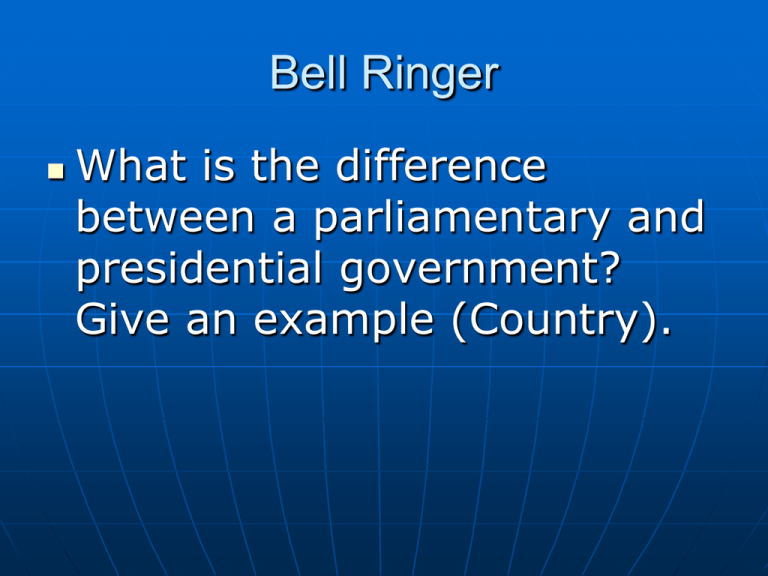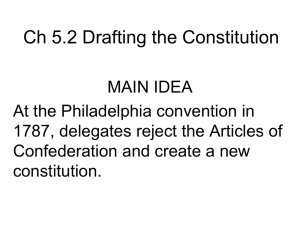Chapter 1 U.S. Government
advertisement

Bell Ringer What is the difference between a parliamentary and presidential government? Give an example (Country). Chapter 2 U.S. Government How Our Constitution was created Chapter 2 Vocabulary Magna Carta Bicameral Confederation Boycott Articles of Confederation Ratification Constitution Federalists Anti-Federalists Constitution Definition • A nation’s basic law. It creates political institutions, assigns or divides powers in government, and often provides certain guarantees to citizens. Sets the broad rules of government. The 200+ year old document is still utilized today because it is not “specific” Romo choked British Colonial Policies Until the mid-1700s, the colonies were allowed a great deal of freedom in their governments by the English monarchy. After the English victory in the FrenchIndian War: • In 1760, King George III imposed new taxes and laws on the colonists to pay the war debts • The colonists started a confederation, proposed an annual congress, and began to rebel. Important English Documents The way our government works today can be traced to important documents in history: The Continental Congresses First Continental Congress The colonists sent a Declaration of Rights to King George III. The delegates urged each of the colonies to refuse all trade with England until British tax and trade regulations were repealed. Second Continental Congress In 1775, each of the 13 colonies sent representatives to this gathering in Philadelphia. On July 4, 1776, the Declaration of Independence was adopted. The Declaration of Independence listed specific grievances against the King. The Second Continental Congress served as the first government of the United States from 1776 to 1781. The Government That Failed The Articles of Confederation • The first document to govern the United States • Congress had few powers (could not tax); States held most power. • States could engage in foreign trade; promised to obey Congress; respect the laws of the other states; and contribute money to congress Weaknesses of the Articles of Confederation One vote for each State, regardless of size. Congress powerless to lay and collect taxes or duties. Congress powerless to regulate foreign and interstate commerce. No executive to enforce acts of Congress. No national court system. Amendment only with consent of all States. A 9/13 majority required to pass laws. Articles only a “firm league of friendship.” The Government That Failed The Aborted Annapolis Meeting • An attempt to discuss changes to the Articles of Confederation. • Attended by only 12 delegates from 5 states. • Called for a meeting in May 1787 to further discuss amendments to the Articles of Confederation. The Government That Failed Economic Turmoil • States had different currencies • States had laws that favored debtors Shays’ Rebellion • A series of attacks on courthouses by a small band of farmers led by Revolutionary War Captain Daniel Shays to block foreclosure proceedings. The Agenda in Philadelphia The Economic Issues • States had tariffs on products from other states • Paper money was basically worthless • Congress couldn’t raise money • National government was powerless to act to stop domestic disturbances; e.g. Shay’s Rebellion • Actions taken: • Powers of Congress to be strengthened • Powers of states to be limited The Madisonian Model Limiting Majority Control Separating Powers Creating Checks and Balances Establishing a Federal System The Madisonian Model The Constitution and the Electoral Process: The Original Plan (Figure 2.2) The Madisonian Model Figure 2.3 The Madisonian Model The Constitutional Republic • Republic: A form of government in which the people select representatives to govern them and make laws. Limiting Majority Control Separating Powers Creating Checks and Balances Establishing a Federal System Differences between the Delegates The Virginia Plan Three branches of government Bicameral legislature “National Executive” and “National Judiciary” The New Jersey Plan Unicameral Congress Equal representation for States of different sizes More than one federal executive Constitutional Compromises The Connecticut Compromise Delegates agreed on a bicameral Congress, one segment with equal representation for States, and the other with representation proportionate to the States’ populations. The Three-Fifths Compromise The Framers decided to count a slave as threefifths of a person when determining the population of a State. The Commerce and Slave Trade Compromise Congress was forbidden from taxing exported goods, and was not allowed to act on the slave trade for 20 years. The Federalists and AntiFederalists The Constitution was very controversial at first, with some groups supporting it, and others attacking it. Federalists thought that the Articles of Confederation were weak, and argued for the ratification of the Constitution. Anti-Federalists objected to the Constitution for many reasons, including the strong central government and the lack of a bill of rights. Constitutional Change Figure 2.4 Constitutional Change The Informal Process of Constitutional Change • Judicial Interpretation • Changing Political Practice • Technology • Increasing Demands on Policymakers Notebook Questions For Ch 2 1. 2. 3. 4. 5. 6. What caused the colonists to seek independence from England? What ideas were contained in the Declaration of Independence? Briefly describe the government set up by the Articles of Confederation? Compare and contrast the Virginia Plan and the New Jersey Plan. Summarize the 3 major compromises that the delegates agreed to. What were the two major concerns the AntiFederalists held in opposing ratification of the Constitution?







